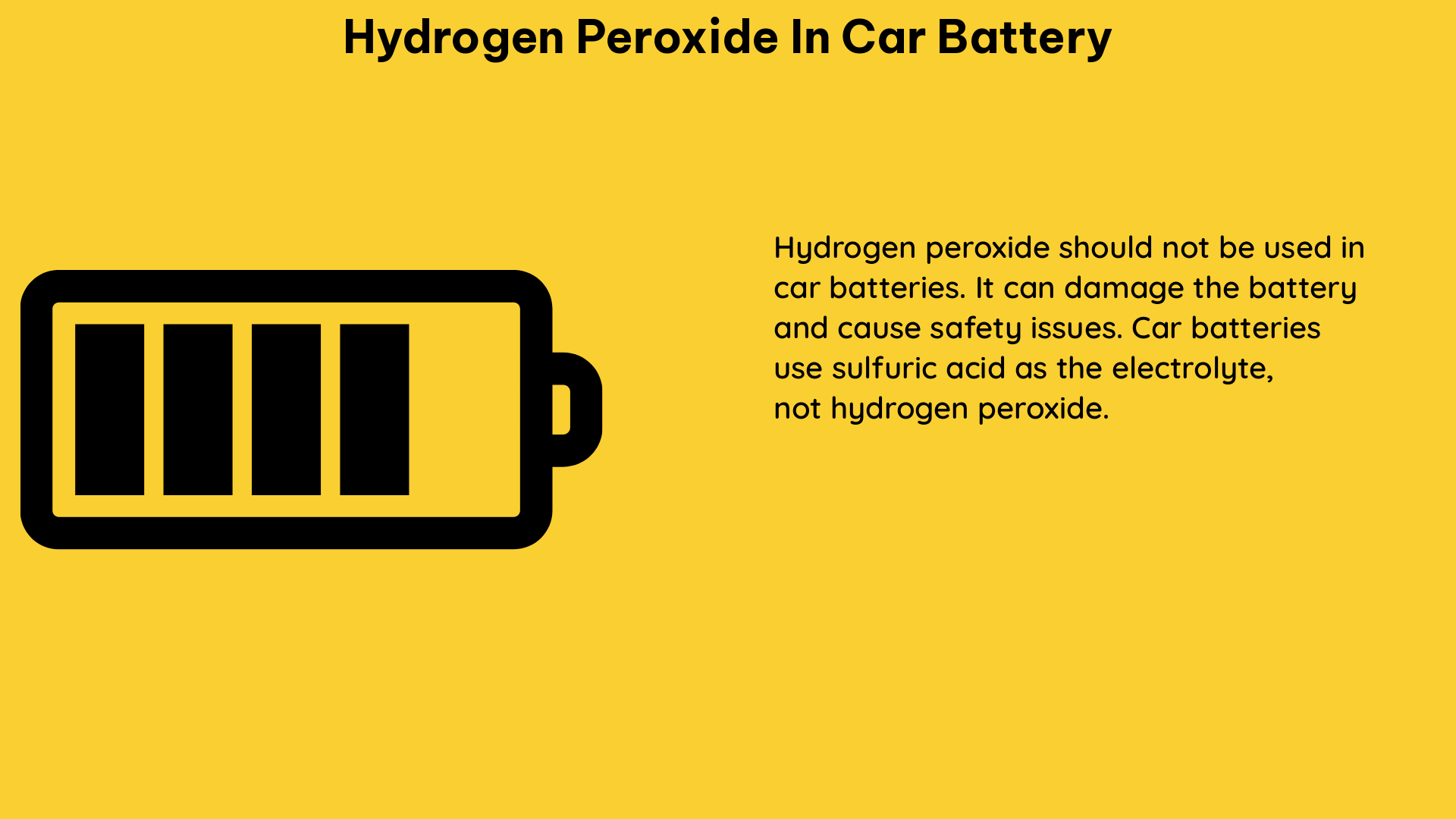Hydrogen peroxide (H2O2) has long been touted as a potential solution for improving the performance and capacity of car batteries. According to a patent, adding specific quantities of saccharides, sodium tetraborate, and hydrogen peroxide to the electrolyte can result in a capacity increase of up to 106% of the nominal value. Additionally, the patent mentions that adding hydrogen peroxide to the electrolyte can smooth the regeneration of the battery’s electrodes, making it a valuable tool for car owners looking to extend the life of their batteries.
Understanding the Science Behind Hydrogen Peroxide in Car Batteries
The addition of hydrogen peroxide to a car battery can have a significant impact on its performance and capacity due to its unique chemical properties. Hydrogen peroxide is a highly reactive and unstable compound that can readily break down into water (H2O) and oxygen (O2). This free oxygen molecule can then interact with the other molecules in the battery, helping to restore power and use to the battery, particularly in cases of severe sulfation.
Saccharides and Sodium Tetraborate: The Key Ingredients
According to the patent, the addition of specific quantities of saccharides and sodium tetraborate to the hydrogen peroxide solution can further enhance the battery’s performance. The saccharides, such as solid glucose, act as a stabilizing agent, helping to prevent the rapid decomposition of the hydrogen peroxide. The sodium tetraborate, on the other hand, helps to regulate the pH of the electrolyte, ensuring optimal conditions for the battery’s electrochemical reactions.
| Ingredient | Quantity |
|---|---|
| Saccharides (solid glucose) | 3.5g per 1 liter of 30% aqueous H2O2 solution |
| Sodium Tetraborate | 5g per 1 liter of 30% aqueous H2O2 solution |
By carefully balancing the concentrations of these key ingredients, the patent claims that a capacity increase of up to 106% of the nominal value can be achieved.
Restoring Severely Sulfated Batteries
In addition to improving overall battery performance, hydrogen peroxide has also been shown to be effective in restoring severely sulfated wet cell batteries, such as those found in motorcycles. A first-hand account describes the process of filling each cell with hydrogen peroxide, letting it sit for a few hours, and then putting the battery on a slow charge. This simple procedure resulted in a dramatic increase in battery voltage, from 5.5V to 12.5V, within just an hour.
DIY Hydrogen Peroxide Battery Rejuvenation

If you’re interested in trying this technique to improve the performance of your car battery, here’s a step-by-step guide:
- Determine the Quantities: Based on the technical specifications provided, calculate the appropriate amounts of saccharides, sodium tetraborate, and hydrogen peroxide solution needed for your battery.
- Prepare the Solution: Mix the specified quantities of saccharides and sodium tetraborate into the hydrogen peroxide solution, ensuring a homogeneous mixture.
- Add the Solution to the Battery: Carefully add the prepared solution to the battery’s electrolyte, taking care not to overfill or spill.
- Let it Sit: Allow the battery to sit for a few hours, giving the hydrogen peroxide time to interact with the other components.
- Charge the Battery: Put the battery on a slow charge, monitoring the voltage and capacity as it charges.
- Monitor Performance: Observe the battery’s performance and capacity over time, making adjustments to the solution or charging process as needed.
Remember, safety should always be the top priority when working with car batteries and chemical solutions. Wear appropriate personal protective equipment, work in a well-ventilated area, and follow all safety guidelines provided by the battery manufacturer.
Conclusion
Hydrogen peroxide has the potential to be a game-changer for car battery performance and longevity. By carefully balancing the concentrations of saccharides, sodium tetraborate, and hydrogen peroxide, car owners can unlock significant improvements in their battery’s capacity and power output. Whether you’re dealing with a severely sulfated battery or simply looking to extend the life of your car’s battery, this comprehensive guide provides the technical details and step-by-step instructions you need to get started.
References:
- WO2004082038A2 – Method of regenerating battery cells and regenerative agent for lead batteries
- Ask an Expert: batteries – Science Buddies
- Battery Additives – Yesterday’s Tractors
- Wet cell battery and H2O2! (hydrogen peroxide) – vn750.com
- BU-805: Additives to Boost Flooded Lead Acid – Battery University

The lambdageeks.com Core SME Team is a group of experienced subject matter experts from diverse scientific and technical fields including Physics, Chemistry, Technology,Electronics & Electrical Engineering, Automotive, Mechanical Engineering. Our team collaborates to create high-quality, well-researched articles on a wide range of science and technology topics for the lambdageeks.com website.
All Our Senior SME are having more than 7 Years of experience in the respective fields . They are either Working Industry Professionals or assocaited With different Universities. Refer Our Authors Page to get to know About our Core SMEs.